6.6 /10 2 Votes
8.3/10 TV Country of origin United States First episode date 18 September 1978 | 8/10 IMDb Genre Sitcom Theme music composer Tom Wells Original language(s) English | |||||||||||||||||||||||||||||||||
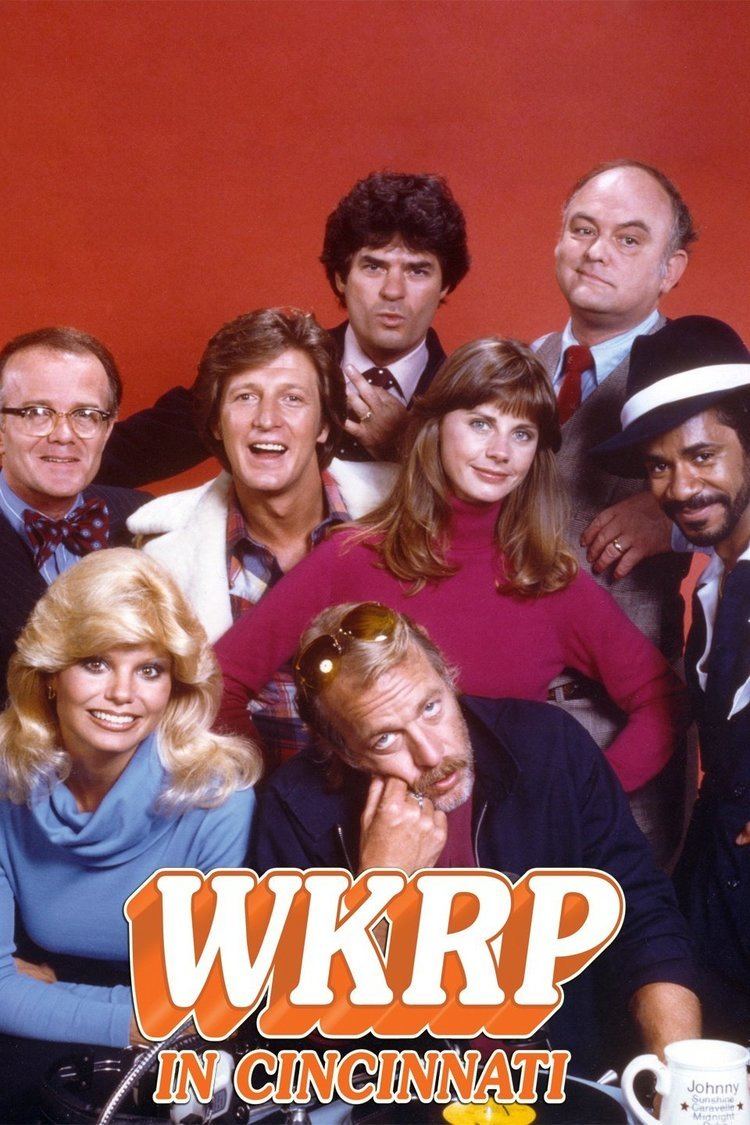 | ||||||||||||||||||||||||||||||||||
Starring Gary SandyGordon JumpLoni AndersonRichard SandersFrank BonnerJan SmithersTim ReidHoward Hesseman Cast | ||||||||||||||||||||||||||||||||||
Wkrp in cincinnati changes
WKRP in Cincinnati is an American sitcom that featured the misadventures of the staff of a struggling fictional radio station in Cincinnati, Ohio. The show was created by Hugh Wilson and was based upon his experiences working in advertising sales at Top 40 radio station WQXI in Atlanta. Many of the characters and even some of the stories (including season 1 episode 7, "Turkeys Away") are based on people and events at WQXI.
Contents
- Wkrp in cincinnati changes
- Wkrp in cincinnati se1ep1 pilot
- Premise
- Main ensemble
- Other characters
- Timeslots and success
- Production
- Real WKRP people
- Transmission tower
- Studios and offices
- A recent WKRP Cincinnati TV station
- Musical themes
- Music licensing
- DVD releases
- References
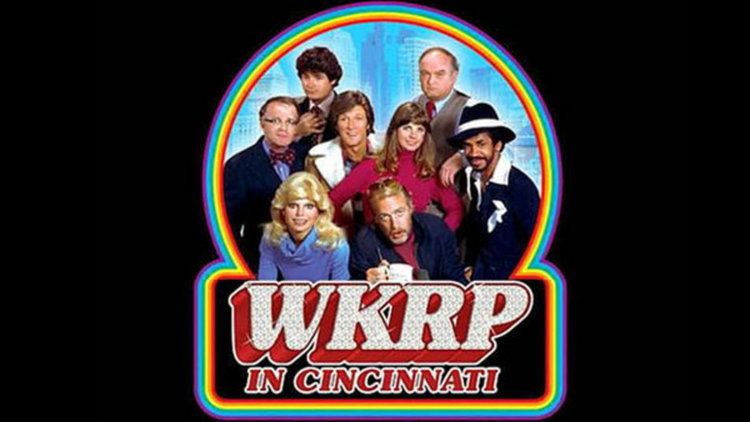
The ensemble cast consists of Gary Sandy, Howard Hesseman, Gordon Jump, Loni Anderson, Tim Reid, Jan Smithers, Richard Sanders and Frank Bonner.
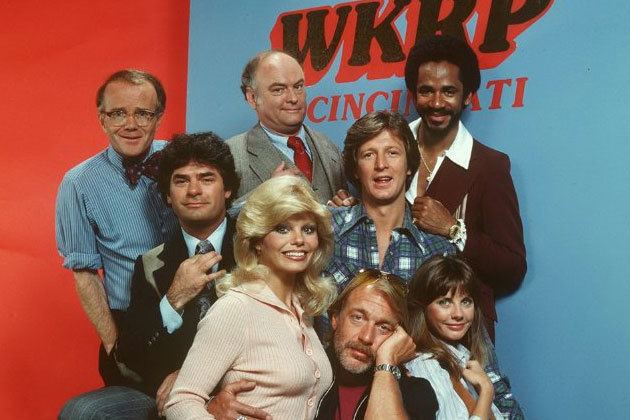
Like many other MTM productions, the humor came more from running gags based on the known predilections and quirks of each character, rather than from outlandish plots or racy situations, since the show has a realistic setting. The characters also developed somewhat over the course of the series.
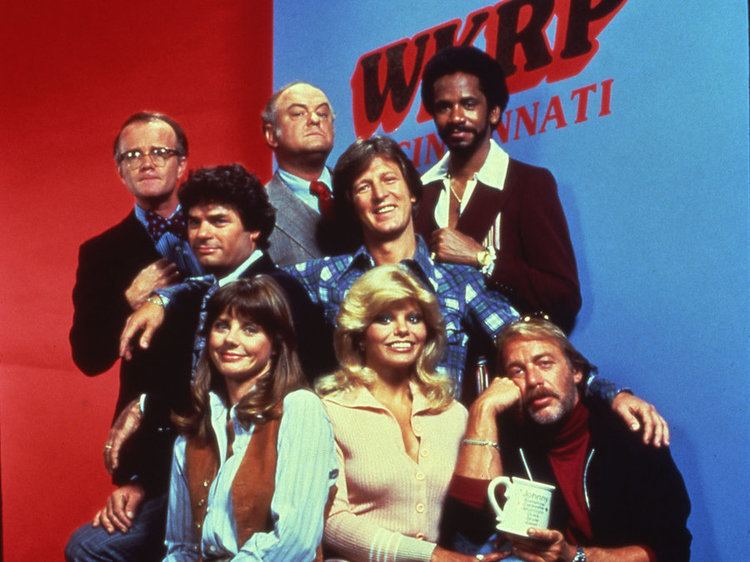
The series won a Humanitas Prize and received 10 Emmy Award nominations, including three for Outstanding Comedy Series. Andy Ackerman won an Emmy Award for Videotape Editing in season 3.
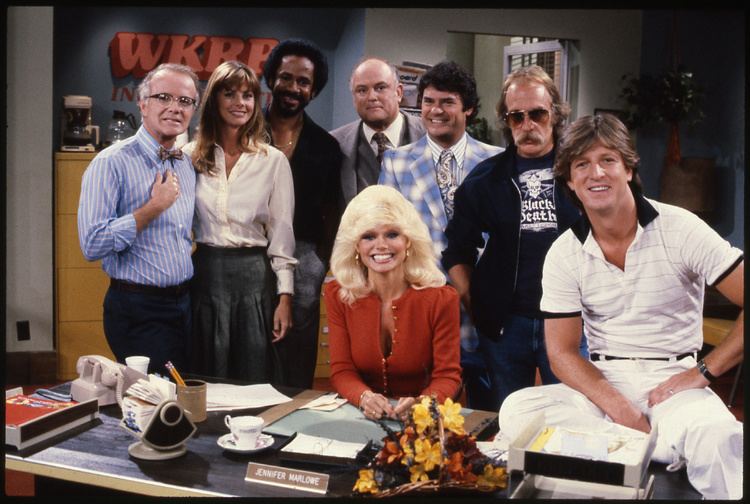
WKRP premiered September 18, 1978 on the CBS television network, and aired for four seasons and 88 episodes through April 21, 1982.
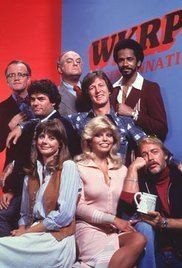
When WKRP went into syndication, it became an unexpected success, despite not reaching the desired number of 100 episodes for daily stripping. (90 half-hour episodes were available for syndication, due to two of the first-run 88 episodes being an hour long.) For the next decade, it was one of the most popular sitcoms in syndication, outperforming many programs which had been more successful in prime time, including all the other MTM Enterprises sitcoms.
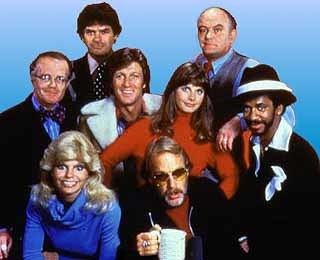
Jump, Sanders, and Bonner reprised their roles, appearing as regular characters in a spin-off/sequel series, The New WKRP in Cincinnati, which ran from 1991 to 1993 in syndication. Hesseman, Reid and Anderson also reprised their roles on this show as guest stars.
Wkrp in cincinnati se1ep1 pilot
Premise
The station's new program director Andy Travis tries to turn around struggling easy listening radio station WKRP by switching its format from dated easy listening music to Rock and roll, despite the well-meaning efforts of the mostly incompetent staff: bumbling station manager Arthur Carlson, greasy sales manager Herb Tarlek, and clueless news director Les Nessman. To help bolster ratings, Travis hires a new disc jockey: New Orleans native Venus Flytrap, and allows spaced-out former major market DJ Dr. Johnny Fever, (already doing mornings in the easy listening format as John Caravella) to be himself. Rounding out the cast are super receptionist Jennifer Marlowe and enthusiastic junior employee Bailey Quarters. Lurking in the background and making an occasional appearance is ruthless business tycoon Mrs. Carlson, the station's owner and the mother of Arthur Carlson.
Main ensemble
Other characters
Timeslots and success
WKRP in Cincinnati debuted in 1978 in CBS’s Monday 8 p.m. timeslot, competing against ABC’s Welcome Back, Kotter and NBC’s top 20 show, Little House on the Prairie. Initially receiving poor ratings, WKRP was put on hiatus after only eight episodes, even though they included some of the most famous of the series, including "Turkeys Away". But owing to good reviews and positive fan reaction, especially from disc jockeys, who immediately hailed it as the first show that realistically portrayed the radio business, CBS decided to bring WKRP back without any cast changes.
WKRP was given a new timeslot, one of the best on the network, following M*A*S*M*A*S*H. This allowed creator Hugh Wilson to move away from farcical radio-based stories, which is what CBS mostly wanted at the beginning, and start telling stories that, while not necessarily serious, were more low-key and character-based. To allow the ensemble cast to mingle more, the set was expanded. A previously unseen communal office area ("the bullpen") was added to accommodate scenes with the entire cast.
Partway through the second season, the show was moved back to its original earlier time. CBS executives wanted to free up the prized post-M*A*S*H slot for House Calls (with former M*A*S*H star Wayne Rogers). They also felt that the rock and roll music and the sex appeal of Loni Anderson were better-suited to the earlier slot, which at that time was thought of as mostly aimed at young people. The mid-season timeslot change didn't affect the show's success; WKRP finished at #22 in the ratings for its second year. For the next two seasons, however, the writers and producers often had to fight CBS over what kind of content was appropriate for a show in the so-called family hour.
After the fourth season, the network decided not to renew the show. The final first-run episode of WKRP aired on April 21, 1982, and ranked #7 in the weekly Nielsen ratings. The episode ended on a cliffhanger, because when it was produced, cast and crew had expected the series to be renewed. Prior to the broadcast, however, the series had already been cancelled.
Production
WKRP was videotaped in Hollywood before a live studio audience at KTLA's Goldenwest Videotape Division, later moving to the CBS Studio Center lot in Studio City.
"Real" WKRP people
While Andy Travis received his name and some personality elements from a cousin of creator Hugh Wilson, he was based primarily on innovative program director Mikel Herrington, who also was the inspiration for the character Jeff Dugan in the 1978 film FM, written by Ezra Sacks who had worked at KMET. Dr. Johnny Fever was based on a DJ named "Skinny" Bobby Harper at WQXI/790 in Atlanta, Georgia (in 1968). WKRP writer Bill Dial worked with Harper at WQXI, which is considered Dial's inspiration for the show. Coincidentally, Harper had previously worked at Cincinnati AM Top 40 powerhouse WSAI in 1964, before moving to 11 other stations, including seven in Atlanta. In 1997, Bobby Harper told WSB's Condace Pressley, "He went on record as pointing out which ones, including myself, that he based the characters on. [That recognition] was a nice little thing. You know? That was nice. I appreciated that."
Transmission tower
The transmission tower seen at the beginning of WKRP in Cincinnati actually belonged to Cincinnati's NBC affiliate, WLWT. The tower has since been dismantled.
Studios and offices
In the show, WKRP's offices and studios are in the Osgood R. Flimm Building, an art deco office building. When mentioned, the exact floor varies: in Season 1's episode "Les on a Ledge", WKRP is on the 9th floor, but in season 4's episode "Fire", it's on the 14th, the entranceway door is shown as 1412. The building shown during the show's opening credits is actually the Cincinnati Enquirer Building at 617 Vine Street in downtown Cincinnati.
A recent WKRP Cincinnati TV station
In 2008, an unrelated independent television station in Cincinnati, WBQC-LD, took advantage of local nostalgia for the sitcom, promoting its conversion to digital broadcasting by rebranding as "WKRP-TV Cincinnati".
Musical themes
WKRP had two musical themes, one opening and the other closing the show.
The opening theme, a soft rock/pop number called "WKRP In Cincinnati Main Theme," was composed by Tom Wells, with lyrics by series creator Hugh Wilson, and was performed by Steve Carlisle. An urban legend circulated at the time that Richard Sanders (who had comparable vocal characteristics to Carlisle) had recorded the song. Wilson stated in the commentary for the first season's DVD set that this was simply not true. (Sanders would later "sing" the lyrics in a promo spot on VH1 for The New WKRP in Cincinnati, which parodied the U2 song, "Numb.")
A full-length version of the original theme song was released in 1979 on a 45 rpm vinyl single on the MCA Records label. It peaked at 65 on the Billboard Hot 100 chart in 1981 and at 29 on the Adult Contemporary chart in 1982. The lyrics refer to the life of character Andy Travis.
The closing theme, "WKRP In Cincinnati End Credits," was a hard rock number composed and performed by Jim Ellis, an Atlanta musician who recorded some of the incidental music for the show. According to people who attended the recording sessions, Ellis didn't yet have lyrics for the closing theme, so he improvised a semi-comprehensible story about a bartender to give an idea of how the finished theme would sound. Wilson decided to use the words anyway, since he felt that it would be funny to use lyrics that were deliberate gibberish, as a satire on the incomprehensibility of many rock songs. Because CBS always had an announcer talking over the closing credits, Wilson knew that no one would hear the closing theme lyrics. In one pop-cultural nod to the closing theme, a character performs the song in the film Ready to Rumble. The closing theme is also played at the end of the syndicated morning radio show The John Boy and Billy Big Show.
Music licensing
The show's use of Blondie's "Heart of Glass" was widely credited with helping the song become a major U.S. hit, and the band's record label Chrysalis Records presented the producers with a gold record award for the album Parallel Lines, on which the song appeared. This gold record can be seen hanging on the wall in the "bullpen" where Les, Herb, and Bailey worked in many of the episodes in the second, third, and fourth seasons.
The songs were often tied into the plot of the episode, and some pieces of music were even used as running gags. For example, the doorbell to Jennifer's penthouse apartment played "Fly Me to the Moon" (which was later replaced by "Beautiful Dreamer" due to copyright reasons).
Music licensing deals cut at the time of production were for a limited number of years. Hugh Wilson commented that WKRP was videotaped instead of filmed because when the show was originally produced, a loophole in music licensing deals reduced fees for using songs in videotaped programs. The loophole was intended to accommodate variety shows. When the show initially went in syndication shortly after its 1982 cancellation, the original music remained intact because the licensing deals were still active at the time. Once the licenses expired, later syndicated versions of the show did not feature the music as first broadcast, but rather generic "sound-alikes" by studio musicians to avoid paying additional royalties. In some cases (when the music was playing in the background of a dialogue scene), some of the characters' lines had to be redubbed by sound-alike actors. This was evident in all prints of the show issued since the early 1990s, which included its late-1990s run on Nick at Nite.
The expense of procuring licenses for the original music in the series delayed any release of a DVD set for years. When it finally was released, much of the music was replaced by generic substitutes. Some scenes were shortened or cut entirely, and voiceovers were used to avoid using unlicensed musical content. However, some scenes that were originally edited out for television (and therefore never seen before) were added back into the episodes to give viewers the back story which further explained a later scene.
DVD releases
20th Century Fox Home Entertainment released the first season on DVD in Region 1 in April 2007. Due to heavy music replacement, sales of the set were poor, and Fox released no further seasons. In May 2014, Shout! Factory acquired rights to the series for DVD release. Shout! Factory planned to include all of the music that aired originally on the show, but was only able to obtain rights for 111 of the original musical artists. Shout! Factory's disclaimer stated, "In a few cases, it was simply impossible to get the rights." Fans of the show compiled lists documenting that the re-release included 80% of the series' original music.
The complete series was available online at shoutfactory.com in September followed by a wide release in October 2014. In March 2015 Shout! released individual sets for Seasons 1 & 2. Season 3 was released in July 2015 and the final season was released in November 2015.
